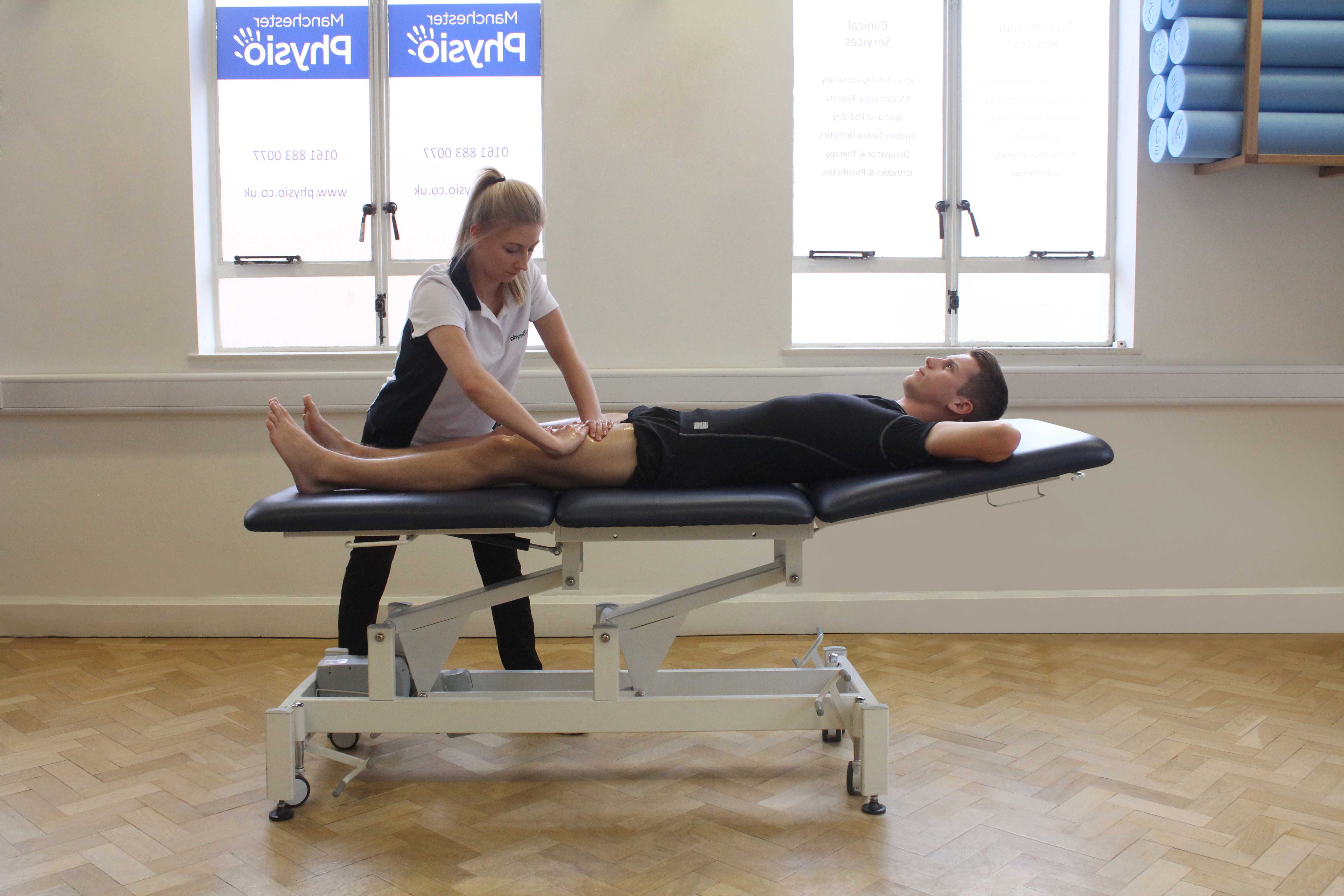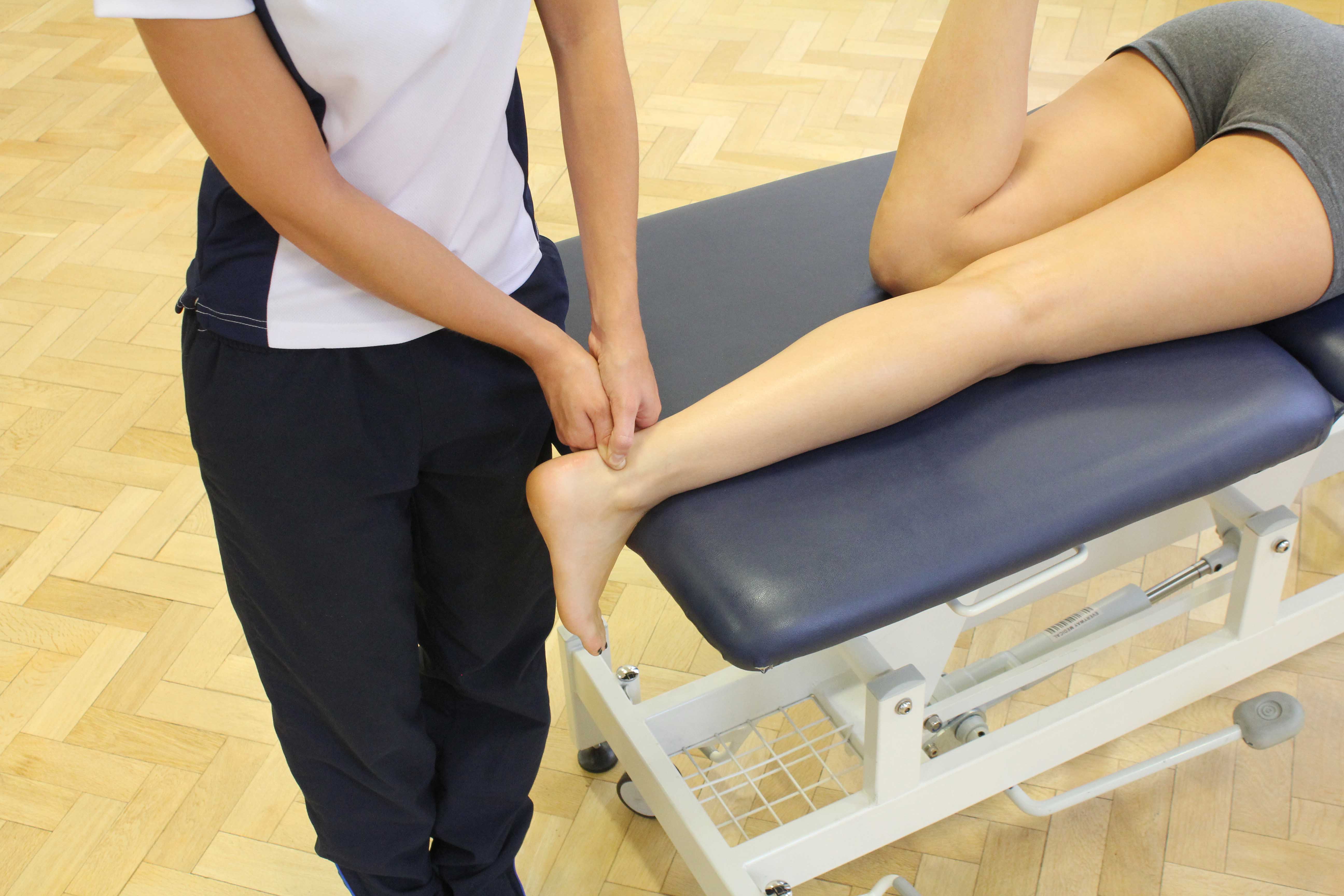Massage can play an important part of pain management due to the effective techniques that are able to stimulate the pain pathways. Massage is a non-pharmacological therapy treatment that is successfully used within pain management. It's a direct strategy at easing pain through a holistic approach that concentrates on the whole body rather than just a specific area as occasionally the pain being experience could be referred from a different area.
Pain is very much a subjective feeling that can be disabling and can be a very stressful experience. It can have a massive effect on the quality of life not only for the individual but their family and friends. Different types of massage such as Swedish and sports massage can have a direct effect on pain due to the different techniques incorporated into the massage that release pain relieving endorphins such as serotonin and oxytocin.
 Above: Soft Tissue Massage targeting quadriceps muscle group
Above: Soft Tissue Massage targeting quadriceps muscle group
The body is a fascinating and complex organism; the pain we experience can take many forms and sensations such as stabbing, throbbing and dull. The way massage works to relieve pain is that it is able to manipulate the nervous system through manual touch which can release the body's natural pain killers and reduce stress hormones in the process. When the muscle is stimulated through touch of the specialist it activates what is known as the muscle spindle which has links to the brain. This transmits a signal to the brain which then sends an output to the muscle telling it to relax. This helps to release the tension that is built up within the muscles which can be an underlying reason pain is felt.
 Above: Transverse friction massage applied to the achilles tendon
Above: Transverse friction massage applied to the achilles tendon
Another way the pain is reduced is that the massage stimulates the touch receptors that travel to the brain on fibres that can transmit signals faster than the ones pain travel on. Injured muscles or tight muscles are constantly sending signals to the brain which is then translated as the feeling of pain. Though regular massage the signals can be distracted and blocked by the sensation of touch especially in chronic conditions where there is a slow dull aching pain present.
 Above: Soft tissue massage and mobilisations applied to the cervical spine
Above: Soft tissue massage and mobilisations applied to the cervical spine
A massage can have a drastic effect on the management of pain related disorders. A massage that helps to relax the mind and the body can make all the difference and can help increase the mood of the individual. Massage as a form of treatment should definitely be incorporated into a pain management plan as it helps:-
Pain is a subjective feeling that only the individual themselves can identify with. Through the use of massage many pain related disorders can be addressed and relieved through a regular massage. The specialists at Liverpool Physio have extensive knowledge and experience with dealing with different types of pain which can be alarming to the individual. Regular massage helps to reduce the feeling of pain and helps to improve the quality of life.
How to book an appointment
For further information on how massage therapy can help treat your pain email us on office@liverpoolphysio.co.uk or call 0151 558 0077.
↑ Back to top
Pain is very much a subjective feeling that can be disabling and can be a very stressful experience. It can have a massive effect on the quality of life not only for the individual but their family and friends. Different types of massage such as Swedish and sports massage can have a direct effect on pain due to the different techniques incorporated into the massage that release pain relieving endorphins such as serotonin and oxytocin.
 Above: Soft Tissue Massage targeting quadriceps muscle group
Above: Soft Tissue Massage targeting quadriceps muscle groupHow massage works for pain relief
The body is a fascinating and complex organism; the pain we experience can take many forms and sensations such as stabbing, throbbing and dull. The way massage works to relieve pain is that it is able to manipulate the nervous system through manual touch which can release the body's natural pain killers and reduce stress hormones in the process. When the muscle is stimulated through touch of the specialist it activates what is known as the muscle spindle which has links to the brain. This transmits a signal to the brain which then sends an output to the muscle telling it to relax. This helps to release the tension that is built up within the muscles which can be an underlying reason pain is felt.
 Above: Transverse friction massage applied to the achilles tendon
Above: Transverse friction massage applied to the achilles tendonAnother way the pain is reduced is that the massage stimulates the touch receptors that travel to the brain on fibres that can transmit signals faster than the ones pain travel on. Injured muscles or tight muscles are constantly sending signals to the brain which is then translated as the feeling of pain. Though regular massage the signals can be distracted and blocked by the sensation of touch especially in chronic conditions where there is a slow dull aching pain present.
 Above: Soft tissue massage and mobilisations applied to the cervical spine
Above: Soft tissue massage and mobilisations applied to the cervical spineBenefits of massage for pain relief
A massage can have a drastic effect on the management of pain related disorders. A massage that helps to relax the mind and the body can make all the difference and can help increase the mood of the individual. Massage as a form of treatment should definitely be incorporated into a pain management plan as it helps:-
- Increase serotonin
- Reduces pain in a natural way
- Increase range of movement
- Improves mood
- Lowers chances of depression
- Improves sleep
- Reduces stress
- Improves quality of life
- Stimulates damaged tissues
Summary
Pain is a subjective feeling that only the individual themselves can identify with. Through the use of massage many pain related disorders can be addressed and relieved through a regular massage. The specialists at Liverpool Physio have extensive knowledge and experience with dealing with different types of pain which can be alarming to the individual. Regular massage helps to reduce the feeling of pain and helps to improve the quality of life.
How to book an appointment
For further information on how massage therapy can help treat your pain email us on office@liverpoolphysio.co.uk or call 0151 558 0077.

↑ Back to top


















